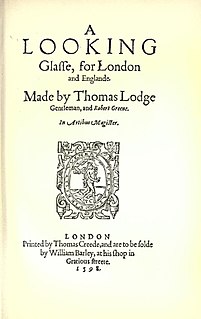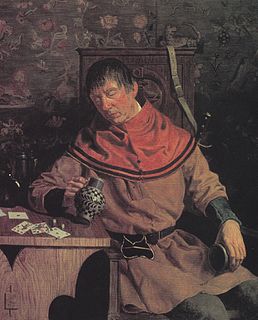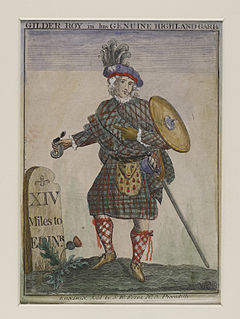Related Research Articles

Richard Turpin was an English highwayman whose exploits were romanticised following his execution in York for horse theft. Turpin may have followed his father's trade as a butcher early in his life but, by the early 1730s, he had joined a gang of deer thieves and, later, became a poacher, burglar, horse thief and killer. He is also known for a fictional 200-mile (320 km) overnight ride from London to York on his horse Black Bess, a story that was made famous by the Victorian novelist William Harrison Ainsworth almost 100 years after Turpin's death.
Anthony Munday was an English playwright and miscellaneous writer. He was baptized on 13 October 1560 in St Gregory by St Paul's, London, and was the son of Christopher Munday, a stationer, and Jane Munday. He was one of the chief predecessors of Shakespeare in English dramatic composition, and wrote plays about Robin Hood. He is believed to be the primary author of Sir Thomas More, on which he is believed to have collaborated with Henry Chettle, Thomas Heywood, William Shakespeare, and Thomas Dekker.

Thomas Lodge, the son of Lord Mayor of London, Thomas Lodge, was an English writer and author during the Elizabethan and Jacobean periods.

Francis Russell, 2nd Earl of Bedford, KG of Chenies in Buckinghamshire and of Bedford House in Exeter, Devon, was an English nobleman, soldier, and politician. He was a godfather to the Devon-born sailor Sir Francis Drake. He served as Lord Lieutenant of Devon (1584-5).

Claude Du Vall was a French highwayman in Restoration England. He came from a family of decayed nobility, and worked in the service of exiled royalists who returned to England under King Charles II. Little else is known of his history. According to popular legend, he abhorred violence, showing courtesy to his victims and chivalry to their womenfolk, thus spawning the myth of the romantic highwayman, as taken up by many novelists and playwrights.

Edward "Ned" Alleyn was an English actor who was a major figure of the Elizabethan theatre and founder of the College of God's Gift in Dulwich.

Henry Wriothesley, 3rd Earl of Southampton, , was the only son of Henry Wriothesley, 2nd Earl of Southampton, and Mary Browne, daughter of Anthony Browne, 1st Viscount Montagu. Shakespeare's two narrative poems, Venus and Adonis and The Rape of Lucrece, were dedicated to Southampton, who is frequently identified as the Fair Youth of Shakespeare's Sonnets.

Sir Thomas Tresham was a prominent recusant Catholic landowner in Elizabethan Northamptonshire. He died two years after the accession of James VI and I.

Thomas Percy was a member of the group of provincial English Catholics who planned the failed Gunpowder Plot of 1605. A tall, physically impressive man, little is known of his early life beyond his matriculation in 1579 at the University of Cambridge, and his marriage in 1591 to Martha Wright. In 1596 his second cousin once removed, Henry Percy, 9th Earl of Northumberland, appointed him constable of Alnwick Castle and made him responsible for the Percy family's northern estates. He served the earl in the Low Countries in about 1600–1601, and in the years before 1603 was his intermediary in a series of confidential communications with King James VI of Scotland.

Elizabeth, Lady Coke, was an English court office holder. She served as lady-in-waiting to the queen consort of England, Anne of Denmark. She was the daughter of Thomas Cecil, 1st Earl of Exeter, and Dorothy Neville, and the granddaughter of William Cecil, 1st Baron Burghley. She was the wife of Sir William Hatton and later of Sir Edward Coke.

Lucy Russell, Countess of Bedford (1580–1627) was a major aristocratic patron of the arts and literature in the Elizabethan and Jacobean eras, the primary non-royal performer in contemporary court masques, a letter-writer, and a poet. She was an adventurer (shareholder) in the Somers Isles Company, investing in Bermuda, where Harrington Sound is named after her.
Henry Simms, known as Young Gentlemen Harry, was a thief and highwayman in 18th-century England who was transported to Maryland for theft, but escaped and returned to England, where he was eventually executed for highway robbery.
Sir John Talbot of Grafton, Worcestershire was a prominent recusant English Catholic layman of the reigns of Elizabeth I of England and James I of England. He was connected by marriage to one of the Gunpowder Plot conspirators, and by acquaintance or family ties to other important Catholic figures. He fell often under suspicion from the English government.

Raffles, the Amateur Cracksman is a 1917 American silent film starring John Barrymore and Evelyn Brent. The movie also co-stars Frank Morgan and Mike Donlin, and was directed by George Irving. The film has been released on DVD.

The Famous Victories of Henry the fifth: Containing the Honourable Battel of Agin-court: As it was plaide by the Queenes Maiesties Players, is an anonymous Elizabethan play, which is generally thought to be a source for Shakespeare's Henriad. It was entered by printer Thomas Creede in the Stationers' Register in 1594, but the earliest known edition is from 1598. A second quarto was published in 1617.
Sir Charles Danvers, was an English MP and soldier who plotted against Elizabeth I of England.

The Devil and His Boy is a 1998 young adult novel by Anthony Horowitz. The book is set in Tudor times and follows the adventures of a young boy as he meets several influential people from that time period.

Bardolph is a fictional character who appears in four plays by William Shakespeare. He is a thief who forms part of the entourage of Sir John Falstaff. His grossly inflamed nose and constantly flushed, carbuncle-covered face is a repeated subject for Falstaff's and Prince Hal's comic insults and word-play. Though his role in each play is minor, he often adds comic relief, and helps illustrate the personality change in Henry from Prince to King.

Best known as Gilderoy or Gilroy, Patrick McGregor was a Scottish outlaw and blackmailer who ravaged the lands of Strathspey, Braemar, Cromarty, and other areas in the vicinity of Aberdeen during the reign of Charles I (1600–1649). He is remembered in published stories, Scottish ballads, tunes, popular expressions, etc. Various other renderings of his name exist such as Gilder Roy and Gilleroy.

Sir John Eyre (1580–1639), initially of Great Chalfield Manor, Wiltshire and later of St. Giles-in-the-Fields, Middlesex was an English courtier, ambassador and Member of Parliament.
References
- ↑ & Collier 1605, p. 4.
- ↑ & Collier 1605, p. 11.
- ↑ Liapi, Lena (2019). Roguery in Print: Crime and Culture in Early Modern London. Boydell & Brewer. ISBN 9781783274406.
- ↑ & Collier 1605, p. 18.
- ↑ Loxley, James (17 July 2013). "Daylight Robbery". University of Edinburgh . Retrieved 17 October 2016.
- Attribution
![]() This article incorporates text from a publication now in the public domain : "Ratsey, Gamaliel". Dictionary of National Biography . London: Smith, Elder & Co. 1885–1900.
This article incorporates text from a publication now in the public domain : "Ratsey, Gamaliel". Dictionary of National Biography . London: Smith, Elder & Co. 1885–1900.
- Bibliography
- Ratsey, Gamaliel (1605). Collier, John (ed.). The Life and Death of Gamaliel Ratsey, a Famous Thief of England: Executed at Bedford the 26 of March Last Past.